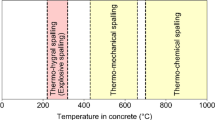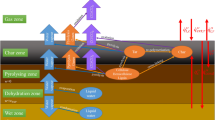Abstract
The performance of the wood-frame buildings after tornadoes has shown that the majority of the wind damage resulted from building envelope failure most typically due to the loss of the roof. To assess the performance and the reliability of low-rise wood-frame residential buildings with a focus on the roofs, fragility analysis can be used to estimate the probability of failure of a roof when constructed with specified nails and sheathing sizes. Thus, this paper examines the fragility of specific types of nails, roof-to-wall (RW) connection details, and sheathing sizes based on the damaged roofs that were previously assessed in the Dunrobin area in Ottawa (Ontario) that was hit with an Enhanced Fujita (EF3) tornado on September 21, 2018. The presented fragility analysis considers four scenarios, including different sheathing and nail sizes. Dead loads, wind loads, and resistance on the sheathing panels were compiled and analyzed to determine the failure of the examined roofs. The eight fragility models suggest that the safest roof sheathing (RS) is the 1.22 m × 1.22 m sheathing panel with 8 d nails, and the safest RW connections is achieved by using H2.5 hurricane clips.
Similar content being viewed by others
Abbreviations
- C :
-
structural capacity
- C e :
-
exposure factor
- C g :
-
gust effect factor
- C p :
-
external pressure coefficient
- C t :
-
topographic factor
- D :
-
structural demand
- Fr :
-
fragility function
- I w :
-
importance factor
- ln:
-
lognormal function
- LS:
-
limit state
- p f :
-
probability of failure
- q :
-
reference velocity pressure
- R C :
-
resistance of the nail/clip connection
- R D :
-
resistance of the dead load of the connection
- RS:
-
roof sheathing
- R W :
-
resistance of the dead load on the roof panel
- RW:
-
roof-to-wall
- R 2 :
-
residual
- S i :
-
inverse of cumulative distribution function (CDF) WL: wind force
- W p :
-
wind pressure
- IM :
-
intensity measure
- x :
-
a vector of the random variables associated for the calculation of capacity and demand
- λ :
-
slope of probability paper plot λR: lognormal median of capacity
- ξ R :
-
lognormal standard deviation of capacity
- ξ :
-
slope of probability paper plots
- φ :
-
standard normal cumulative distribution
References
Brooks H E, Doswell III C A. Normalized damage from major tornadoes in the United States: 1890–1999. Weather and Forecasting, 2001, 16(1): 168–176
Kopp G A, Gavanski E. Effects of pressure equalization on the performance of residential wall systems under extreme wind loads. Journal of Structural Engineering, 2012, 138(4): 526–538
Gill A, Genikomsou A S. Reconnaissance of buildings impacted by the 2018 tornadoes in Ottawa, Canada. Journal of Performance of Constructed Facilities, 2020, 34(4): 04020074
Mehta K C, Minor J E, McDonald J R. Wind speed analysis of April 3–4 tornadoes. Journal of the Structural Division, 1976, 102(9): 1709–1724
Ellingwood B R, Rosowsky D V, Li Y, Kim J H. Fragility assessment of light-frame wood construction subjected to wind and earthquake hazards. Journal of Structural Engineering, 2004, 130(12): 1921–1930
Amini M O, van de Lindt J W. Quantitative insight into rational tornado design wind speeds for residential wood-frame structures using fragility approach. Journal of Structural Engineering, 2014, 140(7): 04014033
Gavanski E, Kopp G A. Fragility assessment of roof-to-wall connection failures for wood-frame houses in high winds, ASCE-ASME J. Risk Uncertainty Eng. Systems, Part A. Civil Engineering, 2017, 3(4): 04017013
Kopp G A, Hong E, Gavanski E, Stedman D, Sills D M. Assessment of wind speeds based on damage observations from the Angus (Ontario) tornado of June 17 2014. Canadian Journal of Civil Engineering, 2017, 44(1): 37–47
Rosowsky D V, Cheng N. Reliability of light-frame roofs in highwind regions. I: wind loads. Journal of Structural Engineering, 1999, 125(7): 725–733
NAHB. Reliability of Conventional Residential Construction: An Assessment of Roof Component Performance in Hurricane Andrew and Typical Wind Regions of the United States. Washington, D.C.: The Office of Policy Development and Research, 1999
O. Reg. 332/12: Building Code, Ontario’s Building Code. Ontario: Government of Ontario, 2020
Lee K H, Rosowsky D V. Fragility assessment for roof sheathing failure in high wind regions. Engineering Structures, 2005, 27(6): 857–868
Ellingwood B. Development of A Probability-Based Load Criterion for American National Standard A58: Building Code Requirements for Minimum Design Loads in Buildings and Other Structures. Washington, D.C.: US Department of Commerce, National Bureau of Standards, 1980
Canadian Commission on Building and Fire Codes. National Building Code of Canada. Ottawa: National Research Council of Canada, 2015
Environment and Climate Change Canada: Enhanced Fujita Scale. Toronto: Environment Canada, 2013
Billah A H M, Shahria Alam M. Seismic fragility assessment of highway bridges: A state-of-the-art review. Structure and Infrastructure Engineering, 2015, 11(6): 804–832
Balomenos G P, Kameshwar S, Padgett J E. Parameterized fragility models for multi-bridge classes subjected to hurricane loads. Engineering Structures, 2020, 208: 110213
Balomenos G P, Padgett J E. Fragility analysis of pile-supported wharves and piers exposed to storm surges and waves. Journal of Waterway, Port, Coastal, and Ocean Engineering, 2018, 144(2): 04017046
Bernier C, Padgett J E. Fragility and risk assessment of aboveground storage tanks subjected to concurrent surge, wave, and wind loads. Reliability Engineering & System Safety, 2019, 191: 106571
Li Y, Ellingwood B R. Hurricane damage to residential construction in the US: Importance of uncertainty modeling in risk assessment. Engineering Structures, 2006, 28(7): 1009–1018
Bayat F, Daneshjoo N, Nistico N, Pejovic J. Seismic evaluation of isolated skewed bridges using fragility function methodology. Computers and Concrete, 2017, 20(4): 419–427
Kwon S Y, Yoo M, Hong S. Earthquake risk assessment of underground railway station by fragility analysis based on numerical simulation. Geomechanics and Engineering, 2020, 21(2): 143–152
Beilic D, Casotto C, Nascimbene R, Cicola D, Rodrigues D. Seismic fragility curves of single storey RC precast structures by comparing different Italian codes. Earthquakes and Structure, 2017, 12(3): 359–374
Ramseyer C, Holliday L, Floyd R. Enhanced residential building code for tornado safety. Journal of Performance of Constructed Facilities, 2016, 30(4): 04015084
Acknowledgements
The first and the second authors would like to thank the Natural Sciences and Engineering Council of Canada for the financial support provided through the grant: RGPIN-2017-04197 NSERC DG. Any findings, conclusions, or recommendations expressed in this manuscript are those of the authors and do not necessarily reflect the sponsor’s views.
Author information
Authors and Affiliations
Corresponding author
Rights and permissions
About this article
Cite this article
Gill, A., Genikomsou, A.S. & Balomenos, G.P. Fragility assessment of wood sheathing panels and roof-to-wall connections subjected to wind loading. Front. Struct. Civ. Eng. 15, 867–876 (2021). https://doi.org/10.1007/s11709-021-0745-5
Received:
Accepted:
Published:
Issue Date:
DOI: https://doi.org/10.1007/s11709-021-0745-5




